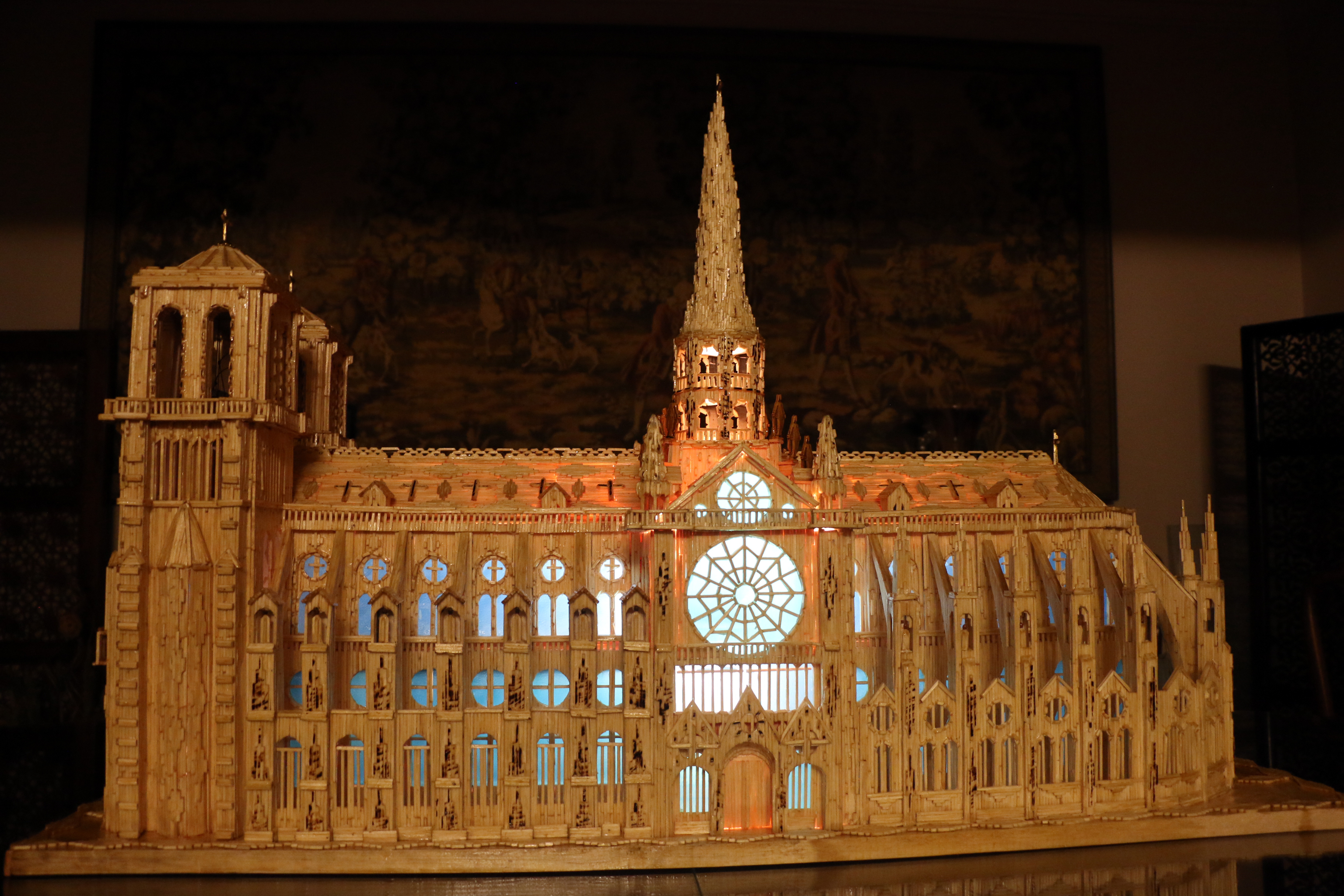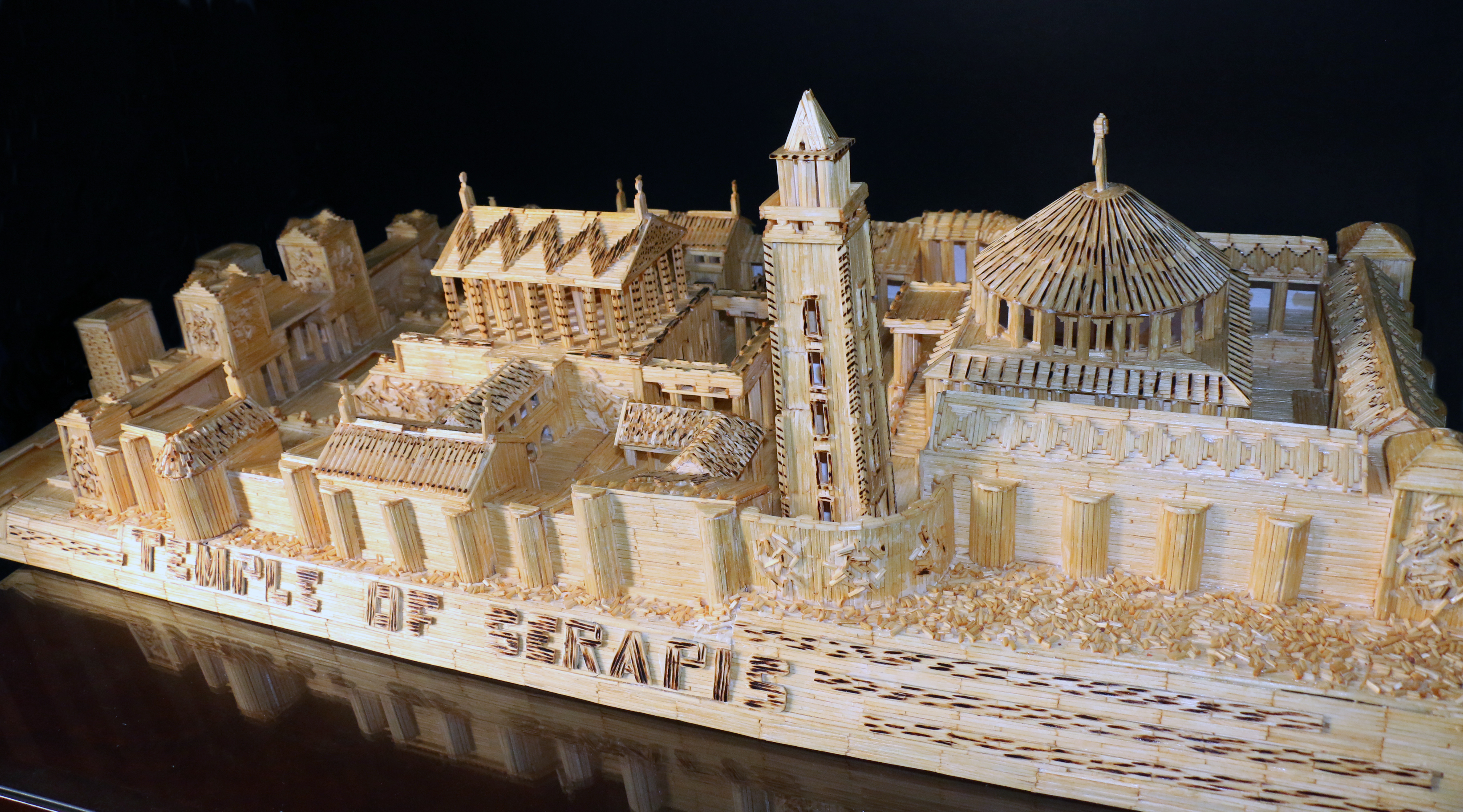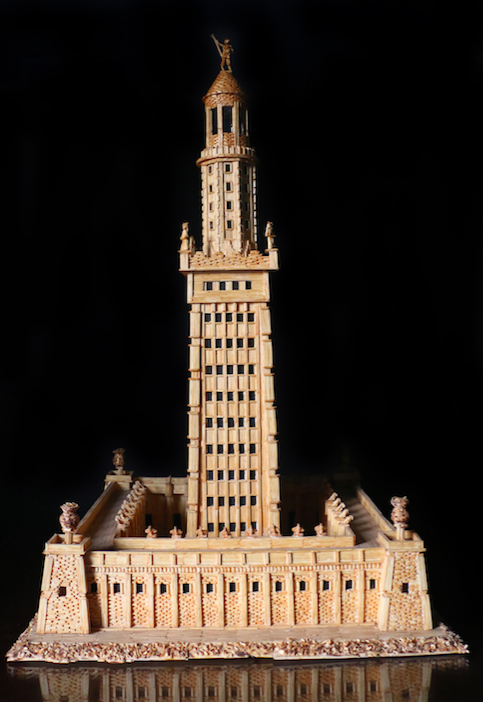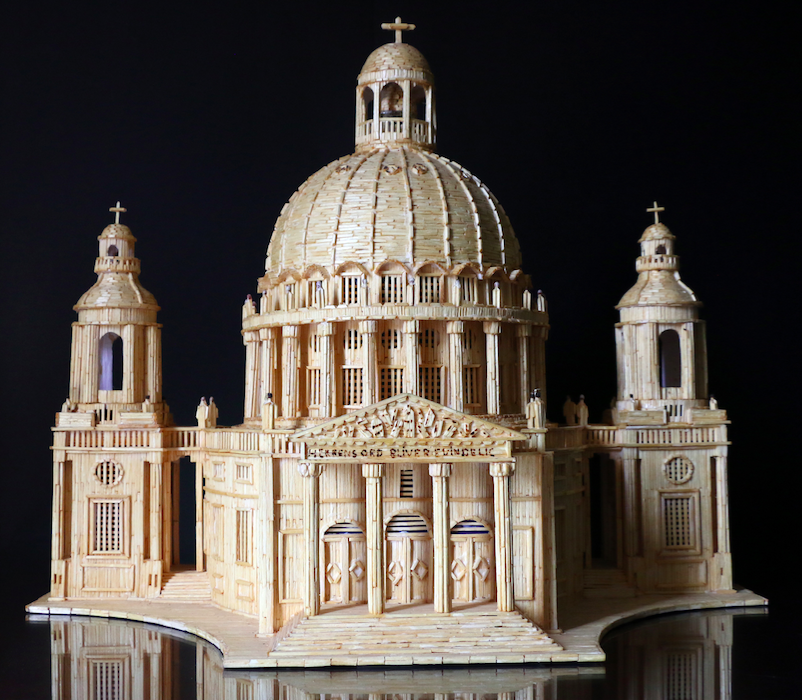One of the perks of growing up with an artist is that you get to live the backstory of every piece of art. This one that I am about to share with you started with a small vitrine that has been in the corner of our living room for as long as I can remember, always closed with a key and very strict restrictions. Inside were small models of antique cars, mosques, and other famous historical buildings, all made entirely of matches. . . . No wonder no one was allowed to come close.
A few years ago, 63-year-old physician and multi-talented artist Dr. Ahmed Hassan, who also happens to be my father, started growing his collection to include structures from all over the world in bigger sizes and more intricate details. This month, he finally sits for an interview to speak about how his passion for match crafts started decades ago, and how he gradually developed his own techniques and vision for this beautiful art.

It was a news piece I read years ago. We used to have a section in newspapers called light news. The article was about a person somewhere in the world who makes models with matches. I began with two matchboxes and some adhesive material, starting with very simple shapes, then I kept developing it. The first thing I made was a small kiosk. I taught myself how to make the window and door and a small chimney. It was all trial and error.
And why did you choose matches rather than any other common material?
It is easy and available. And at the same time, I like to put together pieces to create something bigger and not the opposite, like sculpturing for example where you would start with a big piece and carve it to get something smaller.
How did you develop the craft further? How did you add your own personal touch to it?
It was a gradual process. As I wanted to do more complex shapes like a car for example, I ran across problems like the circled wheel; how to do it? I thought about it in different ways until I managed to do it. . . . And it kept evolving afterward.
Whenever I face a problem in the execution, I need to find a solution for it. The problem is often in the circles and round pieces. I used to do it differently before; but I was not satisfied with the results. So I introduced a new technique where I make the whole shape in paper first then I cover it all with matches.
The idea is that I have my material, the adhesive material and very simple tools; and I try as possible to make it look similar to the real thing. And so far, every problem I have faced to achieve this, I found a solution for. The small details usually take more time and effort.

At the beginning, I chose simple things and not direct replications. For example, to make a boat, I would envision the shape I wanted. When I felt that I reached a good level, I started looking for photos and imitating them with matches; cars, boats, buildings. It took years for me to reach the phase I am at now.
Recently, you’ve been working on historic and beautiful buildings from around the world. Give me some examples of what you made so far.
From Egypt, if we start from the oldest to the newest, the oldest two structures I have made are the Alexandria Lighthouse, one of the seven wonders of the word; and the old library of Alexandria and the adjoining temple of Serapis. If we move forward in history, I also made a model of the Qaitbay Citadel in Alexandria; and in Cairo, the old Khedive Opera House which burned down in the 1970s. There’s also the Baron Palace, the Sakakini Palace, the Montazah Palace, also the Basilica Church where the Baron was buried. And I made the Sahabah Mosque in Sharm El-Sheikh.
From other countries around the world, there are the Notre Dame and Sacre Coeur churches in Paris, the Naval Cathedral in Russia, Frederick church in Denmark and, most recently, London Bridge.
Then there are old boats, military and commercial. And I made models of the Mahrousa boat and the Suez Canal Authority building which I gifted to the Suez Canal Museum. There are also some folklore pieces like the ful and sweet potato carts and fanoos Ramadan.

How do you pick these structures?
The primary factor for me is the aesthetics of the building. This is what captures my attention the most, regardless of the type of the building. I see that the general shape is pretty; so I try to turn it from a photo into a three-dimensional model. There are other factors as well, such as [my desire] to revitalize old historical buildings, whether Egyptian or not, or [to bring to life] buildings that we have only seen in photos. It is a journey, where I look for beautiful things. I do not try to think much about the historic background or why the building was made this way. It is just a beautiful structure and I try to highlight that with my models.
And once you choose the building, what steps do you follow?
First, I collect as much information as I can about the building from all sides, because they will all be visible in the model. I find the architectural drawings if available; some old buildings have websites that provide these photos so I benefit from them. I choose one photo to measure the scale of the building so that it is accurate. I then determine the facets of the building and put them on paper, with the scale I am using.
Each building consists of three or four dimensions; and I start doing the match work based on the drawing. Each side can consist of five or six layers, depending on the building itself. I put together the whole thing, then I polish it with emery paper.
Lastly, I start ornamenting it. And in this step, I give myself some freedom to add more than what is there in reality. This is either because I can’t reach the level of detail in the real thing with my material, like a statue; or I feel like in some buildings, some walls are so plain . . . In the size of the real building, this might not be very visible but in a small model, you would see every small detail. However, the ornament in general should always be suitable for the style of the building, whether it is Islamic, and so on.
The idea is that when I stand in front of a building that is hundreds of times my size, I can never capture everything. My sight is usually directed to specific things or the part I am standing in front of. What I make can only be seen from a plane for example, where you can take a look at the whole building; and at the same time, you can see the details. So I am combining between two things that the viewer cannot see by standing in front of the building.
What can you do with matches that cannot be done using wood for example?
It is the last step in the process. You can make the whole building in wood but I think that the decoration cannot be done using wood. Wood used to make models is very fragile so you cannot carve it afterward; other wood cannot be cut in such small pieces that allow to create the needed ornaments. [That’s where] I think matches give me [an advantage]; the rest of the model can all be made with wood but it will only be walls and a roof without the aesthetic part matches add].

Why don’t you color the buildings?
I like to let the material stand out. The colors will completely hide the material. The matches themselves give different shades when exposed to the light afterward depending on the direction of the match. So the model at the end has different shades of colors. Moreover, I felt that keeping the models like this give them a sense of authenticity and rootage more than with colors.
You didn’t study architecture or engineering. How do you make up for such needed skills when you want to create models in the right scale and details?
It was all practice. I have some idea about how to read architectural drawings, and I know a bit about plans and elevations. But it was mostly practice and not education.
How much time does a piece take?
On average, I spend four or five hours a day. So it depends on the size of the model and the needed efforts. But the smallest thing would take between two and three weeks. And the big ones can take months.

What is the biggest model you have made so far in terms of size?
In terms of space, it was the old library of Alexandria with the Serapis temple. But in terms of height, I think the biggest is the Sahaba mosque in Sharm El-Sheikh. It is very high because the minaret is very big. Then, the Notre Dame is the second biggest; it is 98 centimeters in length, around 40 in width, and 75 centimeters high. I started working on it three or four days after the fire, as I was moved by the pictures in the media. It took almost three months.
Do you feel the difference when you work on a building that you have already seen in reality or not?
I’d say 99% of the buildings I made I have not seen with my eyes, or maybe I have seen them from a distance. I depend mainly on the photos.
Are you considering organizing workshops or teaching other people to follow the same path?
If I find enough enthusiasm from someone, I would love to. But it would be a problem of time. So far, many people have expressed their admiration of the work but I do not think anyone showed the enthusiasm to learn it or to do it.
You don’t sell any of your products. So what are you planning to do with them?
I don’t have a problem with selling them. But if I sell a piece to one person, I think I will be burying the piece as no one else will see it. I don’t mind giving them to exhibitions or museums; I don’t even mind donating them as I already did with the Suez Canal Authority. The purpose is not the material benefit but that the people see and enjoy the work.
What’s the message that you want to send through the models?
It is a journey to look for something beautiful that exists or existed in our lives, to try to highlight it and present it to people in a way that brings happiness. And also I consider it a way to immortalize heritage that people do not know much about. If they like the building, this could also make people want to know more about it.

Comments
Leave a Comment